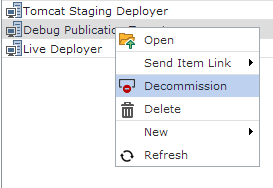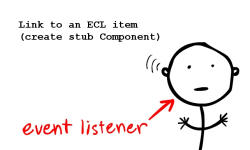In case you missed it, let me share some highlights of the Tridion Developer Summit in Amsterdam this year. This year was a year of changes, it is the first time since the history of TDS that I didn’t present, I even missed the first half of the opening day, since my flight was delayed. Let me start off with the real beginning of TDS though, the preparations and workshops.
Author Archives: Bart
Removing Node.js dependency from the reference implementation
The whole idea of the reference implementation was to make your life (the life of a SDL Tridion developer) easier. But sometimes people make mistakes, and then the end result can be slightly more difficult than it was intended to be.
This blog post is not so much a confession of what I did wrong, but more intended to help you see how easy things can be changed when the tool you use was designed to be simple and modular.
Reference Implementation HTML design
By now I assume that everybody has had a little play with the SDL Tridion Reference Implementation, which means the questions are rising for sure. So let me start with spilling some of the guts of the HTML design and how that is build when you publish.
To start off, the HTML design is a responsive HTML5 design built Bootstrap, this means that you can adjust it to your own likings following the Bootstrap methodology. This includes building the HTML design with Node.js and Grunt, but let’s start off simple.
Even more fun with Experience Manager
After writing my post about having fun with experience manager last year, I think it is time for a small update. This time I’ll keep it short, but we will have even more fun with XPM!
ECL and BluePrinting

Many have asked me, “Does ECL support BluePrinting”? My reply is always a solid yes, but (yes there is a but), I should really reply with a question: “Does your external system support BluePrinting”?
Since it is nice that ECL supports BluePrinting, but ECL just exposes items from your external system in SDL Tridion. So for them to be BluePrinted, you should have your ECL Provider make the connection between an SDL Tridion Publication and the specific items you want to show in that context. An ECL item URI contains a Publication URI, so to implement BluePrinting correctly in your provider, you will need to give the child item, the same ECL Item ID as its parent item. The only thing that is tricky there is localization, an ECL item doesn’t really have a localized state, the ECL stub Component can have that state though.
SDL Tridion for Dummies – a proposal
 People have been asking me for years, to write a SDL Tridion for Dummies book. With the release of SDL Tridion 2013 SP1, our documentation features two new getting started guides (Quick Guide to creating a Page Template and Quick Guide to creating a Component Template, note, the documentation requires login, see here for how to get the login details), and these can be seen as two chapters of a For Dummies book.
People have been asking me for years, to write a SDL Tridion for Dummies book. With the release of SDL Tridion 2013 SP1, our documentation features two new getting started guides (Quick Guide to creating a Page Template and Quick Guide to creating a Component Template, note, the documentation requires login, see here for how to get the login details), and these can be seen as two chapters of a For Dummies book.
Now, while these two new quick guides are a revolutionary step forward for people who are completely new to SDL Tridion, I am still missing the explanation behind them. The guides explain you step by step what you need to do to create your first Page/Component Template based on an HTML design, but afterwards you still might not have a clue about what you actually did (or why you needed to do it).
So let me ask you, do you really need a SDL Tridion for Dummies book – the complete edition – taking it one step further than the documentation?
Forms without Java, XSLT or even XML
 Now you might have heard that I love WebForms and advocate it everywhere I can (which isn’t necessarily true, but let’s say it is for the sake of argument). So why, you may ask, is Bart writing a provider to an online forms solution?
Now you might have heard that I love WebForms and advocate it everywhere I can (which isn’t necessarily true, but let’s say it is for the sake of argument). So why, you may ask, is Bart writing a provider to an online forms solution?
The answer is really quite simple – well that’s what product management said about the idea; because we recognise that our users are using many different tools to enable and facilitate their diverse content management needs and one of these is the ability to create simple online forms. That is why we built the ECL framework and why we continue to look for ways to improve our customer’s content management experience. Actually, the answer is even simpler than that: just because I can, and because I just love ECL and by now I love it more than WebForms.
Decommission a Publication Target
 With the release of SDL Tridion 2013 SP1, we get a lot of new functionality. One of the interesting features I found was the ability to decommission a Publication Target. This feature is added to the Core Service, and currently not directly available from the UI. Which sounded like a good exercise to make a UI extension, with which you can call this new method.
With the release of SDL Tridion 2013 SP1, we get a lot of new functionality. One of the interesting features I found was the ability to decommission a Publication Target. This feature is added to the Core Service, and currently not directly available from the UI. Which sounded like a good exercise to make a UI extension, with which you can call this new method.
It is not too late…
 December is the time to look back, and if you have been doing a sprint of 365 days, now is the time to start to think about the retrospective. That is exactly what the MVP Selection Panel is doing right now. To select the new MVP’s for the SDL Tridion MVP Award program, we need to evaluate each nominee’s voluntary contribution to the SDL Tridion community over the past 12 months. Which is why I would like to mention, it is not too late.
December is the time to look back, and if you have been doing a sprint of 365 days, now is the time to start to think about the retrospective. That is exactly what the MVP Selection Panel is doing right now. To select the new MVP’s for the SDL Tridion MVP Award program, we need to evaluate each nominee’s voluntary contribution to the SDL Tridion community over the past 12 months. Which is why I would like to mention, it is not too late.
ECL event handlers
 In my previous post about ECL, I’ve discussed querying ECL Metadata in the Broker, by making it available as part of the Multimedia (stub) Component Metadata. Now in that post I explained how it could be copied at Publishing time and the “evil” twists that process came with. In this post I’ll discuss an optional approach, using the SDL Tridion Event System which makes the process of copying external metadata to (normal) metadata less evil (just the process, not the fact that we do it ;o).
In my previous post about ECL, I’ve discussed querying ECL Metadata in the Broker, by making it available as part of the Multimedia (stub) Component Metadata. Now in that post I explained how it could be copied at Publishing time and the “evil” twists that process came with. In this post I’ll discuss an optional approach, using the SDL Tridion Event System which makes the process of copying external metadata to (normal) metadata less evil (just the process, not the fact that we do it ;o).